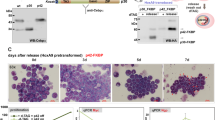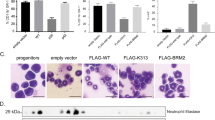Abstract
The transcription factor CCAAT enhancer-binding protein α (C/EBPα) has an important role in granulopoiesis. The tumor suppressor function of C/EBPα is shown by the findings that loss of expression or function of C/EBPα in leukemic blasts contributes to a block in myeloid cell differentiation and to leukemia. C/EBPα mutations are found in around 9% of acute myeloid leukemia (AML) patients. The mechanism by which the mutant form of C/EBPα (C/EBPα-p30) exerts a differentiation block is not well understood. By using a proteomic screen, we have recently reported PIN1 as a target of C/EBPα-p30 in AML. In the present study, we show that C/EBPα-p30 induces PIN1 expression. We observed elevated PIN1 expression in leukemic patient samples. Induction of C/EBPα-p30 results in recruitment of E2F1 in the PIN1 promoter. We show that the inhibition of PIN1 leads to myeloid differentiation in primary AML blasts with C/EBPα mutations. Overexpression of PIN1 in myeloid cells leads to block of granulocyte differentiation. We also show that PIN1 increases the stability of the c-Jun protein by inhibiting c-Jun ubiquitination, and c-Jun blocks granulocyte differentiation mediated by C/EBPα. Our data suggest that the inhibition of PIN1 could be a potential strategy of treating AML patients with C/EBPα mutation.
This is a preview of subscription content, access via your institution
Access options
Subscribe to this journal
Receive 12 print issues and online access
$259.00 per year
only $21.58 per issue
Buy this article
- Purchase on Springer Link
- Instant access to full article PDF
Prices may be subject to local taxes which are calculated during checkout






Similar content being viewed by others
References
Rosenbauer F, Tenen DG . Transcription factors in myeloid development: balancing differentiation with transformation. Nat Rev Immunol 2007; 7: 105–117.
Nerlov C . C/EBPalpha mutations in acute myeloid leukaemias. Nat Rev Cancer 2004; 4: 394–400.
Pabst T, Mueller BU, Zhang P, Radomska HS, Narravula S, Schnittger S et al. Dominant-negative mutations of CEBPA, encoding CCAAT/enhancer binding protein-alpha (C/EBPalpha), in acute myeloid leukemia. Nat Genet 2001; 27: 263–270.
Gombart AF, Hofmann WK, Kawano S, Takeuchi S, Krug U, Kwok SH et al. Mutations in the gene encoding the transcription factor CCAAT/enhancer binding protein alpha in myelodysplastic syndromes and acute myeloid leukemias. Blood 2002; 99: 1332–1340.
Kirstetter P, Schuster MB, Bereshchenko O, Moore S, Dvinge H, Kurz E et al. Modeling of C/EBPalpha mutant acute myeloid leukemia reveals a common expression signature of committed myeloid leukemia-initiating cells. Cancer Cell 2008; 13: 299–310.
Geletu M, Balkhi MY, Peer Zada AA, Christopeit M, Pulikkan JA, Trivedi AK et al. Target proteins of C/EBPalphap30 in AML: C/EBPalphap30 enhances sumoylation of C/EBPalphap42 via up-regulation of Ubc9. Blood 2007; 110: 3301–3309.
Lu KP . Prolyl isomerase Pin1 as a molecular target for cancer diagnostics and therapeutics. Cancer Cell 2003; 4: 175–180.
Wulf G, Finn G, Suizu F, Lu KP . Phosphorylation-specific prolyl isomerization: is there an underlying theme? Nat Cell Biol 2005; 7: 435–441.
Bao L, Kimzey A, Sauter G, Sowadski JM, Lu KP, Wang DG . Prevalent overexpression of prolyl isomerase Pin1 in human cancers. Am J Pathol 2004; 164: 1727–1737.
Wulf GM, Ryo A, Wulf GG, Lee SW, Niu T, Petkova V et al. Pin1 is overexpressed in breast cancer and cooperates with Ras signaling in increasing the transcriptional activity of c-Jun towards cyclin D1. EMBO J 2001; 20: 3459–3472.
Liou YC, Ryo A, Huang HK, Lu PJ, Bronson R, Fujimori F et al. Loss of Pin1 function in the mouse causes phenotypes resembling cyclin D1-null phenotypes. Proc Natl Acad Sci USA 2002; 99: 1335–1340.
Wulf G, Garg P, Liou YC, Iglehart D, Lu KP . Modeling breast cancer in vivo and ex vivo reveals an essential role of Pin1 in tumorigenesis. EMBO J 2004; 23: 3397–3407.
Lu KP, Hanes SD, Hunter T . A human peptidyl-prolyl isomerase essential for regulation of mitosis. Nature 1996; 380: 544–547.
Rippmann JF, Hobbie S, Daiber C, Guilliard B, Bauer M, Birk J et al. Phosphorylation-dependent proline isomerization catalyzed by Pin1 is essential for tumor cell survival and entry into mitosis. Cell Growth Differ 2000; 11: 409–416.
Rinehart-Kim J, Johnston M, Birrer M, Bos T . Alterations in the gene expression profile of MCF-7 breast tumor cells in response to c-Jun. Int J Cancer 2000; 88: 180–190.
Rangatia J, Vangala RK, Treiber N, Zhang P, Radomska H, Tenen DG et al. Downregulation of c-Jun expression by transcription factor C/EBPalpha is critical for granulocytic lineage commitment. Mol Cell Biol 2002; 22: 8681–8694.
Rangatia J, Vangala RK, Singh SM, Peer Zada AA, Elsasser A, Kohlmann A et al. Elevated c-Jun expression in acute myeloid leukemias inhibits C/EBPalpha DNA binding via leucine zipper domain interaction. Oncogene 2003; 22: 4760–4764.
Lu KP, Zhou XZ . The prolyl isomerase PIN1: a pivotal new twist in phosphorylation signalling and disease. Nat Rev Mol Cell Biol 2007; 8: 904–916.
Porse BT, Pedersen TA, Xu X, Lindberg B, Wewer UM, Friis-Hansen L et al. E2F repression by C/EBPalpha is required for adipogenesis and granulopoiesis in vivo. Cell 2001; 107: 247–258.
Buchner T, Berdel WE, Schoch C, Haferlach T, Serve HL, Kienast J et al. Double induction containing either two courses or one course of high-dose cytarabine plus mitoxantrone and postremission therapy by either autologous stem-cell transplantation or by prolonged maintenance for acute myeloid leukemia. J Clin Oncol 2006; 24: 2480–2489.
D’Alo F, Johansen LM, Nelson EA, Radomska HS, Evans EK, Zhang P et al. The amino terminal and E2F interaction domains are critical for C/EBP alpha-mediated induction of granulopoietic development of hematopoietic cells. Blood 2003; 102: 3163–3171.
Asou H, Gombart AF, Takeuchi S, Tanaka H, Tanioka M, Matsui H et al. Establishment of the acute myeloid leukemia cell line Kasumi-6 from a patient with a dominant-negative mutation in the DNA-binding region of the C/EBPalpha gene. Genes Chromosomes Cancer 2003; 36: 167–174.
Schoch C, Kohlmann A, Schnittger S, Brors B, Dugas M, Mergenthaler S et al. Acute myeloid leukemias with reciprocal rearrangements can be distinguished by specific gene expression profiles. Proc Natl Acad Sci USA 2002; 99: 10008–10013.
Huber W, von Heydebreck A, Sultmann H, Poustka A, Vingron M . Variance stabilization applied to microarray data calibration and to the quantification of differential expression. Bioinformatics 2002; 18 (Suppl 1): S96–S104.
Livak KJ, Schmittgen TD . Analysis of relative gene expression data using real-time quantitative PCR and the 2(-Delta Delta C(T)) method. Methods 2001; 4: 402–408.
Wang QF, Cleaves R, Kummalue T, Nerlov C, Friedman AD . Cell cycle inhibition mediated by the outer surface of the C/EBPalpha basic region is required but not sufficient for granulopoiesis. Oncogene 2003; 22: 2548–2557.
Ryo A, Liou YC, Wulf G, Nakamura M, Lee SW, Lu KP . PIN1 is an E2F target gene essential for Neu/Ras-induced transformation of mammary epithelial cells. Mol Cell Biol 2002; 22: 5281–5295.
Uchida T, Takamiya M, Takahashi M, Miyashita H, Ikeda H, Terada T et al. Pin1 and Par14 peptidyl prolyl isomerase inhibitors block cell proliferation. Chem Biol 2003; 10: 15–24.
Gao M, Labuda T, Xia Y, Gallagher E, Fang D, Liu YC et al. Jun turnover is controlled through JNK-dependent phosphorylation of the E3 ligase Itch. Science 2004; 306: 271–275.
Fang D, Kerppola TK . Ubiquitin-mediated fluorescence complementation reveals that Jun ubiquitinated by Itch/AIP4 is localized to lysosomes. Proc Natl Acad Sci USA 2004; 101: 14782–14787.
Angel P, Hattori K, Smeal T, Karin M . The jun proto-oncogene is positively autoregulated by its product, Jun/AP-1. Cell 1988; 55: 875–885.
Niebuhr B, Iwanski GB, Schwieger M, Roscher S, Stocking C, Cammenga J . Investigation of C/EBPalpha function in human (versus murine) myelopoiesis provides novel insight into the impact of CEBPA mutations in acute myelogenous leukemia (AML). Leukemia 2008; 23: 978–983.
Wang C, Chen X, Wang Y, Gong J, Hu G . C/EBPalphap30 plays transcriptional regulatory roles distinct from C/EBPalphap42. Cell Res 2007; 17: 374–383.
Zhang P, Iwasaki-Arai J, Iwasaki H, Fenyus ML, Dayaram T, Owens BM et al. Enhancement of hematopoietic stem cell repopulating capacity and self-renewal in the absence of the transcription factor C/EBP alpha. Immunity 2004; 21: 853–863.
Ryo A, Liou YC, Lu KP, Wulf G . Prolyl isomerase Pin1: a catalyst for oncogenesis and a potential therapeutic target in cancer. J Cell Sci 2003; 116: 773–783.
Schuster MB, Porse BT . C/EBPalpha: a tumour suppressor in multiple tissues? Biochim Biophys Acta 2006; 1766: 88–103.
MacLachlan TK, Somasundaram K, Sgagias M, Shifman Y, Muschel RJ, Cowan KH et al. BRCA1 effects on the cell cycle and the DNA damage response are linked to altered gene expression. J Biol Chem 2000; 275: 2777–2785.
Wooster R, Weber BL . Breast and ovarian cancer. N Engl J Med 2000; 348: 2339–2347.
Miller M . Phospho-dependent protein recognition motifs contained in C/EBP family of transcription factors: in silico studies. Cell Cycle 2006; 5: 2501–2508.
Porse BT, Bryder D, Theilgaard-Monch K, Hasemann MS, Anderson K, Damgaard I et al. Loss of C/EBP alpha cell cycle control increases myeloid progenitor proliferation and transforms the neutrophil granulocyte lineage. J Exp Med 2005; 202: 85–96.
Johansen LM, Iwama A, Lodie TA, Sasaki K, Felsher DW, Golub TR et al. c-Myc is a critical target for c/EBPalpha in granulopoiesis. Mol Cell Biol 2001; 21: 3789–3806.
Castilla LH . C/EBPalpha in leukemogenesis: a matter of being in the right place with the right signals. Cancer Cell 2008; 13: 289–291.
Vogt PK . Jun, the oncoprotein. Oncogene 2001; 20: 2365–2377.
Elsasser A, Franzen M, Kohlmann A, Weisser M, Schnittger S, Schoch C et al. The fusion protein AML1-ETO in acute myeloid leukemia with translocation t(8;21) induces c-jun protein expression via the proximal AP-1 site of the c-jun promoter in an indirect, JNK-dependent manner. Oncogene 2003; 22: 5646–5657.
Burgess GS, Williamson EA, Cripe LD, Litz-Jackson S, Bhatt JA, Stanley K et al. Regulation of the c-jun gene in p210 BCR-ABL transformed cells corresponds with activity of JNK, the c-jun N-terminal kinase. Blood 1998; 92: 2450–2460.
Cai DH, Wang D, Keefer J, Yeamans C, Hensley K, Friedman AD . C/EBP alpha:AP-1 leucine zipper heterodimers bind novel DNA elements, activate the PU.1 promoter and direct monocyte lineage commitment more potently than C/EBP alpha homodimers or AP-1. Oncogene 2008; 27: 2772–2779.
Schuler A, Schwieger M, Engelmann A, Weber K, Horn S, Muller U et al. The MADS transcription factor Mef2c is a pivotal modulator of myeloid cell fate. Blood 2008; 111: 4532–4541.
Acknowledgements
We thank Dr Alan D. Friedman for BRM2 cell line, Dr Giannino Del Sal, Dr Lu KP and Dr Bruno Calabretta for DNA constructs and Dr George Bornkamm for valuable discussions. This work was supported by grants from Deutsche Jos Leukämie-Stiftung (F06/03) to J.A.P; the National Institute of Health (R01 HL56745) to D.G.T and Deutsche Jos Leukämie-Stiftung, DFG and Krebshilfe to G.B.
Author information
Authors and Affiliations
Corresponding author
Ethics declarations
Competing interests
The authors declare no conflict of interest.
Additional information
Supplementary Information accompanies the paper on the Leukemia website
Supplementary information
Rights and permissions
About this article
Cite this article
Pulikkan, J., Dengler, V., Peer Zada, A. et al. Elevated PIN1 expression by C/EBPα-p30 blocks C/EBPα-induced granulocytic differentiation through c-Jun in AML. Leukemia 24, 914–923 (2010). https://doi.org/10.1038/leu.2010.37
Received:
Revised:
Accepted:
Published:
Issue Date:
DOI: https://doi.org/10.1038/leu.2010.37
Keywords
This article is cited by
-
Pin1 inhibition exerts potent activity against acute myeloid leukemia through blocking multiple cancer-driving pathways
Journal of Hematology & Oncology (2018)
-
Prolyl isomerase Pin1: a promoter of cancer and a target for therapy
Cell Death & Disease (2018)
-
C/EBPα deregulation as a paradigm for leukemogenesis
Leukemia (2017)
-
The presence of C/EBPα and its degradation are both required for TRIB2-mediated leukaemia
Oncogene (2016)
-
The isomerase PIN1 controls numerous cancer-driving pathways and is a unique drug target
Nature Reviews Cancer (2016)



